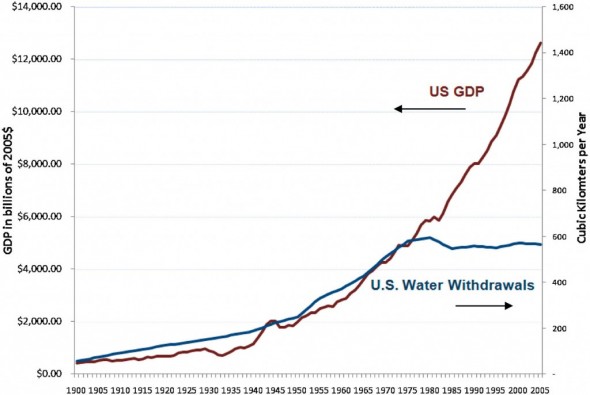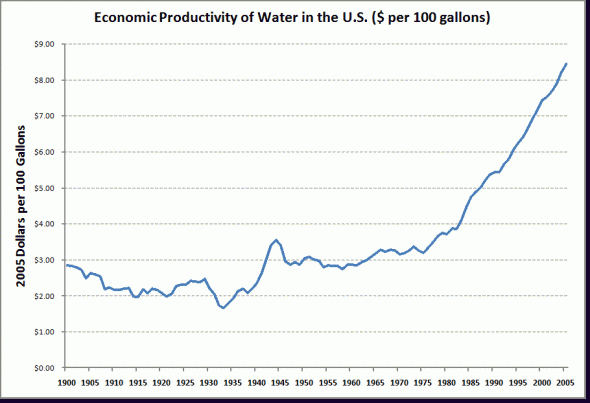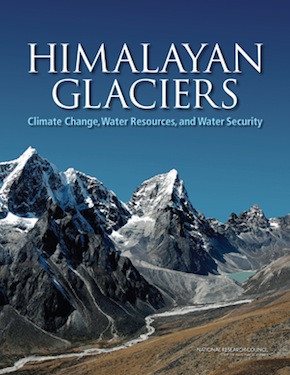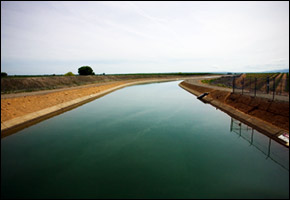Peter Gleick: Is the U.S. Reaching Peak Water?
Adequate, high-quality freshwater is fundamental for health, growing food, natural ecosystems, and a productive U.S. economy including the production of energy and all vital goods and services. But as populations and economies grow, new constraints on water resources are appearing, raising questions about ultimate limits to water availability.
In some parts of the world, including the U.S., the demand for water is outstripping the supply, causing political disputes and economic uncertainty, and raising the specter of “peak water.” Questions about resource availability and limits are not new. The specter of “peak oil”—a peaking and then decline in oil production—has long been predicted and debated, and peak U.S. oil production occurred forty years ago.
But the concept of “peak water” and its implications for the U.S. economy are less well explored and understood. A paper published last year introduced and defined the concept of peak water and The New York Times chose the term “peak water” as one of its 33 “Words of the Year” for 2010.
To be clear, “peak water” doesn’t mean the U.S. or the world is running out of water. Overall, there is plenty of water on the planet and it is (mostly) a renewable resource. But there are serious physical, environmental, and economical constraints on water availability that make regional water problems increasingly urgent. As a result, there are growing efforts in the business and investment communities to understand how risks of water shortages might affect corporate strategy and decisions, and conversely, how to maintain a strong economy in the face of growing freshwater limits. [For example, the UN CEO Water Mandate, the World Business Council for Sustainable Development, the Alliance for Water Stewardship, the World Economic Forum, DEG-WWF Water Risk Filter, and the International Organization for Standardization (ISO), among others, all have water and business-related efforts underway.]
There are three different definitions of “peak water” and there is evidence that the U.S., or parts of the country, have exceeded peak constraints for all three: Peak Renewable Water, Peak Non-Renewable Water, and Peak Ecological Water.
Peak Renewable Water. Most water resources are renewable, in the form of flows of rainfall, rivers, streams, and groundwater basins that are recharged over relatively short time frames. Renewable, however, does not mean unlimited. When human demands for water from a watershed reach 100% of renewable supply, we can’t take any more, and we reach “peak renewable” limits. For a number of major river basins, we have reached the point of peak renewable water limits, including the Colorado River in the United States. All of the water of the Colorado (indeed, more than 100% of the average flow) is already spoken for through legal agreements with the seven US states and Mexico and in a typical year river flows now often fall to zero before they reach their ends. This is true for a growing number of rivers around the world.
Peak Nonrenewable Water. In some places, water comes from stocks of water that are effectively nonrenewable, such as groundwater aquifers with very slow recharge rates or groundwater systems damaged by compaction or other physical changes in the basin. When the use of water from a groundwater aquifer far exceeds natural recharge rates, this stock of groundwater will be depleted or fall to a level where the cost of extraction exceeds the value of the water when used, very much like oil fields. Continued production of water beyond natural recharge rates will become increasingly difficult and expensive as groundwater levels drop, leading to a peak of production, followed by diminishing withdrawals and use. This kind of unsustainable groundwater use is already occurring in the Ogallala Aquifer in the Great Plains of the United States, the North China plains, parts of California’s Central Valley, and numerous regions in India. In these basins, extraction may not fall to zero, but current rates of pumping cannot be maintained. Worldwide, a significant fraction of current agricultural production depends on non-renewable groundwater. This is extremely dangerous for the reliability of long-term food supplies.
Peak Ecological Water. Water supports commercial and industrial activity and human health, but it is also fundamental for animals, plants, habitats, and environmentally dependent livelihoods. By some estimates, humans already appropriate almost 50% of all renewable and accessible freshwater flows, leading to significant ecological disruptions. Since 1900, half of the world’s wetlands have disappeared. The number of freshwater species has decreased by 50% since 1970, faster than the decline of species on land or in the sea. The term “peak ecological water” refers to the point where taking more water for human use leads to ecological disruptions greater than the value that this increased water provides to humans. Economists have long noted the difficulty of quantifying this point because of problems in assigning appropriate valuations to each unit of water or each unit of ecosystem benefit in any watershed, but the mistaken assumption that such values are zero has led to them being highly discounted, underappreciated, or ignored in 20th century water policy decisions.
We have known for many years that some regions of the U.S. face water constraints, especially in the arid west. But recently, new water challenges have emerged in regions once thought to be relatively water rich, like the southeast and even the Great Lakes region. And there is strong evidence that the United States as a whole may have already passed the points of peak water, including peak renewable, nonrenewable, and ecological water. Indeed, when we look at data on total water withdrawals and use in the US (Figure 1) we see that maximum water use actually occurred more than 30 years ago, and that we are now using less water overall, and much less water per person, than in 1980. The bad news is that this suggests we have reached, or passed the point of peak water.

Figure 1. Total water withdrawals have leveled off in the U.S. despite a growing economy and population. Source. Gleick and Palaniappan, PNAS, 2010.
The good news, however, is that the assumption that a growing population and economy require ever growing amounts of water (or other natural resources) may be false. Indeed, as Figure 1 shows, the U.S. has continued to expand our economy and meet the demands of growing populations, with less and less water, through smarter technology, regulations, education, improved water pricing, and water conservation and efficiency programs. Indeed, another way to think about this is to look at what I call the “economic productivity of water use” – that is, the dollars of gross domestic product that we produce with every unit of water used. As shown in Figure 2, this measure of productivity has grown enormously, nearly tripling since the 1970s, even correcting for inflation.

Figure 2. US water productivity has grown over the past several decades. Source: Peter Gleick, Pacific Institute, 2011.
This is good news indeed, and it means that new thinking about water management (and indeed, the management of resources overall) could further strengthen the U.S. economy without increasing our impacts on the environment or our costs for resource extraction and use. Peak water may be a reality, but it doesn’t have to be a constraint on our well-being.
Peter Gleick
Originally published by Forbes on September 7, 2011.











Leave a Reply
Want to join the discussion?Feel free to contribute!